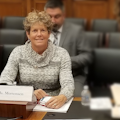OP-ED: Transparent and responsive cost sharing is the key ingredient for intercity passenger rail
The San Joaquin Valley has a long history of punching above its weight. Despite being home to just 10 percent of the state’s population, our region produces the majority of California’s agricultural output – earning the nickname of the food basket of the world – and remains an important national energy and transportation hub. The people of the valley are hardworking and resilient and expect that same ethos from its public services.
At San Joaquin Regional Rail Commission, we strongly embrace this culture and intertwine it into our identity. Our 60 employees are responsible for managing the Altamont Commuter Express (ACE), a commuter rail service that carries more than 1.5 million passengers annually from Stockton into the Bay Area, and the San Joaquins, a top-ten ridership Amtrak state-supported intercity rail route.1
In September, we were awarded a $20 million U.S. Department of Transportation Better Utilizing Investments to Leverage Development (BUILD) grant for the Stockton Diamond Grade Separation project. The diamond is currently a major freight and passenger rail bottleneck that, when untangled, will lead to fewer delays for both freight and passenger trains. The award is a major point of pride of our agency and our region, as we all came together, and stuck together, to advocate for this much needed project.
A key focus for our agency – and a commitment our region demands – is vigilant and watchful spending of our taxpayer dollars. Our agency strives to be lean, efficient and effective. Yet, our unique profile of managing both a commuter rail service and an intercity passenger rail service has highlighted a flaw in the Amtrak State Supported Services program that impedes our ability to maintain that commitment to our taxpayers.
Last November, I testified before the House Transportation & Infrastructure Committee at an Amtrak oversight hearing. I shared with the committee our tale of two services. The ACE service is contracted with Herzog Transit Services, while we utilize Amtrak for the San Joaquins service. With Herzog as our ACE partner, we collaborate daily on train performance, maintenance activities and staffing levels and budget. Herzog, like our agency, prides itself on coming in under budget.
However, our attempts to manage the San Joaquin service in the same responsive and cost-effective way has experienced significant structural challenges. When Congress enacted the Passenger Rail Investment and Improvement Act (PRIIA), the burden of funding intercity passenger rail was shifted to the states and Amtrak was empowered to develop its own cost allocation formulas for state payments. Despite our state’s financial commitment and desire to oversee the service, Amtrak’s lack of data transparency and inability to fairly determine a cost sharing formula has put our San Joaquin Valley tenacity to the test.
Government watchdogs have largely echoed these concerns. Both the Government Accountability Office and Amtrak’s own Inspector General have found that Amtrak has not developed clear information detailing its specific costs and activities on the state-supported route segment.2 In the Inspector General’s report from August, one of our state colleagues detailed that Amtrak is unable to share how much it would cost a state to add an additional car to a train.3
PRIIA’s Section 209 created a national cost-sharing formula and process for state-supported routes, yet as structured, this provision is the source of state and watchdog concerns. A national formula fails to account for the unique circumstances on Amtrak’s individual state-supported routes and enables Amtrak to develop its own cost formulas outside of the disinfecting light of public transparency. Troublingly, Amtrak does not treat state taxpayer contributions to its services the same as the federal dollar.
Amtrak’s national state-supported route policies must be reformed to unlock the potential of state-supported intercity rail in the United States. To remedy this increasingly frustrating and unfair situation, states should only be charged their “direct” cost of service by Amtrak. This change in policy would encourage Amtrak to reform their current accounting and cost allocation practices, providing states the transparency and accountability we require to honestly advocate for continued funding of these services in our state capitals.
The San Joaquin Valley is a diverse and unique area of our country. We are a scrappy bunch and we are not afraid of standing up for what it right, especially when it comes to our limited public dollars. When our riders board either an ACE or Amtrak train, they deserve to have their tax dollars used as effectively as possible by both providers. However, without reform, Amtrak’s state-supported route segment will fail to provide our nation effective, intercity passenger rail.
----------------------
Stacey Mortensen has worked since 1991 in transportation engineering and passenger rail service. She was the founding executive director for the start-up of the Altamont Commuter Express (ACE) Rail Service, which began in 1998.
----------------------
1. Pre-pandemic.
2. United States Government Accountability Office (2016). Amtrak: Better Reporting, Planning and Improved Financial Information Could Enhance Decision Making. https://www.gao.gov/assets/680/674520.pdf.
3. National Railroad Passenger Corporation, Office of Inspector General (2020). Governance: Observations on Amtrak’s Usage of CARES Act Funds. https://amtrakoig.gov/sites/default/files/reports/OIG-MAR-2020-013%20CARES%20Act%20Review_0.pdf.
About the Author

Stacey Mortensen
Executive Director
Stacey Mortensen has worked since 1991 in transportation engineering and passenger rail service. She was the founding executive director for the start-up of the Altamont Commuter Express (ACE) Rail Service which began in 1998. The San Joaquin Regional Rail Commission owns, operates and is the policy-making body for ACE service.
Stacey and her team also manage the San Joaquin Intercity Amtrak Service which runs from Bakersfield to Sacramento and Oakland. This has helped consolidate and coordinate rail planning and operations in northern California.
The valley rail programs were given a big boost through SB1 and now a $1-billion expansion program is underway to add significant new service by 2023 and 2026 and connect to the high-speed rail station in Merced.
In her spare time in the middle of the night, Stacey trains for the worldwide Crossfit Games in the master’s category.
